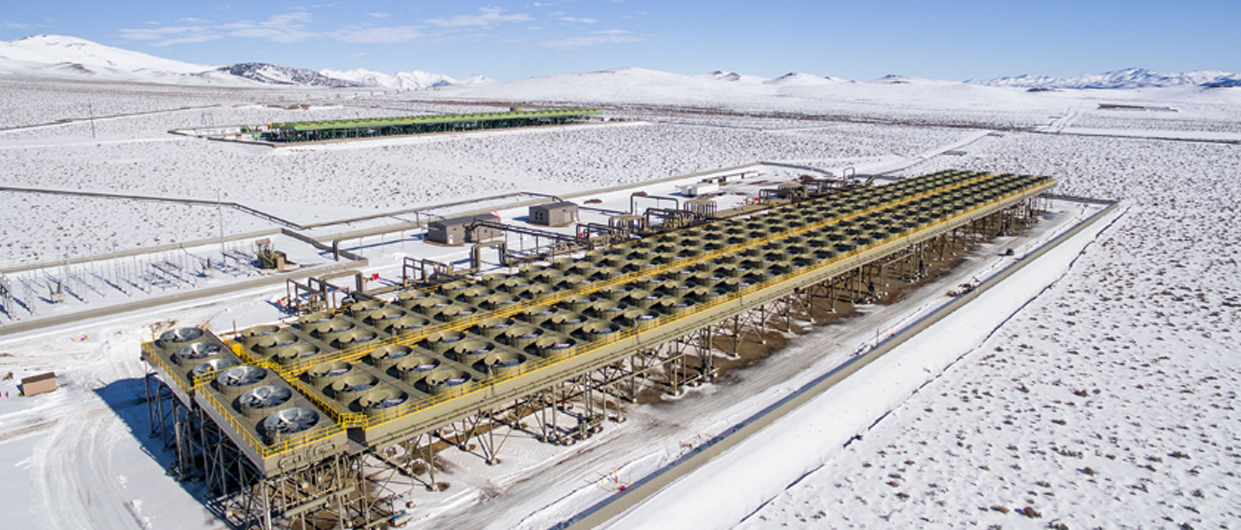The energy contained in a geothermal fluid is defined by its enthalpy, generally given in kilojoules per kilogram (kJ/kg). For a liquid, the enthalpy is primarily determined by its temperature. The electrical energy that can be derived from the geothermal fluid is a function of its mass rate, entry and exit temperatures into and out of the ORC heat exchanger, and the efficiency of the heat exchanger.
For example, a fluid temperature of 180 C contains an enthalpy of 763 kJ/kg. A mass rate of 80 kg/s (equivalent to 90 Liters per second) with an exit temperature of 80 C results in an available energy rate of 32,600 kJ per second (a Watt is defined as 1 Joule per second). This is sometimes referred to as the thermal rate and this example equates to 32.6 Megawatts thermal (MWt).

This energy rate is converted to electricity at some efficiency, depending primarily on the properties of the ORC heat exchanger and ambient conditions. This efficiency generally ranges between 10-16% for the types of ORC units used in geothermal pumped-well projects. Shown in this example is a process with 15.2% efficiency which results in 5 MWe (gross) power output for 80 kg/s mass flow rate.

The example given above is a simplified approximation, but provides a useful overview of the energy conversion process. The enthalpies quoted are approximate for pure water and can vary depending on the total dissolved solids and non-condensable gases contained in the fluid.
This is the third article in a series on Geothermal pumped-well power projects. The first article included a global overview of operating projects and subsurface characteristics and the second one focused on pump hydraulics.
Pump power
A portion of the gross power generated by the ORC units is required to operate the pumps. This load is primarily determined by the flow rate and lift head, which is defined as the vertical height from the first stage pump impellor to surface, plus friction losses and required pressure at the wellhead. In its simplest form, pump power can be estimated by the following:
BHP = [(Q*H*rho)/247,000]/E
Where BHP is the brake horsepower (multiply by 0.75 to convert to kW), Q is the volumetric flowrate in GPM, H is the lift head in feet, rho is the fluid density in pounds per cubic foot (lbs/cf), 247,000 is a constant to reconcile units, and E is the overall pump efficiency (%).
For the example given above, a rough approximation of pump power for a pump rate of 80 kg/s (equivalent to 1,427 GPM) of 180 C water (density 56 lbs/cf) with a total lift head of 2,000 feet and overall pump efficiency of 68% would be about 950 BHP (713 kW). Therefore, in the above example for a power output of 5 MWe (gross), roughly 0.7 MW of this power is used to run the pump.
Net vs Gross Power
In addition to pumps, geothermal pumped-well power projects have other internal power requirements, including re-injection pumps and house load, which take between 5-10% of the gross generated power. As an approximation, pumped-well projects generally consume between 20-25% of the gross generation for own use.
Given the high productivity of pumped wells, modular efficiency of ORC heat exchangers, and proven technology, these type of projects have shown to be very profitable, especially in the western U.S. However, the economics of these projects has several important variables, which are explored in our next installment of geothermal pumped-well power projects.
Elliot Yearsley – enyearsley@gmail.com
Selected references
Crane Technical Paper 410: Flow of Fluids through valves, fittings and pipes (1982).
Culver G.: Chapter 9 Well Pumps, Geo-Heat Center Publications, Klamath Falls, Oregon (1998).
Sanyal S.K., Morrow J.W., Butler S.J.: Geothermal Well Productivity: Why Hotter is Not Always Better. GRC Transactions, Vol. 31 (2007).
Yearsley, E.N.: Common Characteristics of Pumped Wells in Geothermal Power Projects. Proc. of 41st New Zealand Geothermal Workshop (2019).

